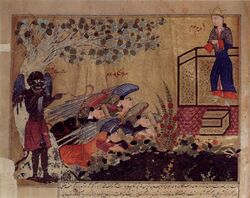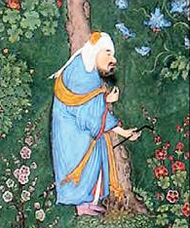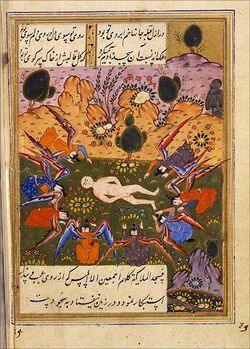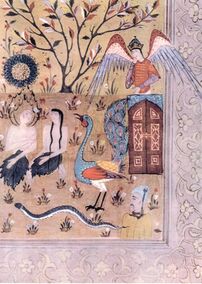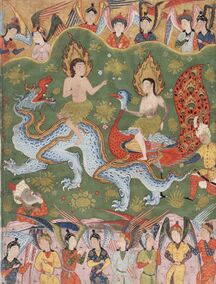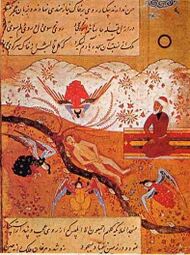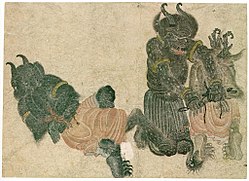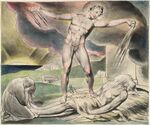Unsolved:Iblis

| Part of a series on |
| Islam |
|---|
 |
|
|
Iblis (Arabic: إِبْلِيسْ),[2] alternatively known as Eblīs,[3] is the leader of the devils (shayāṭīn) in Islam. According to the Quran, Iblis was thrown out of heaven, after he refused to prostrate himself before Adam. Regarding the origin and nature of Iblis, there are two different viewpoints.[4][5]
In the first version, before Iblis was cast down from heaven, he used to be a leading angel called ʿAzāzīl, appointed by God to obliterate the preceding inhabitants of the Earth (usually jinn), who became disobedient and destructive, to replace them with humans.[4] After Iblis objected to God's decision to create Adam as a successor to the previous generation of sentient life, he was punished by being relegated and cast down to Earth as a shayṭān (devil).[4] In the alternative account, God created Iblis from the fires beneath the seventh earth.[4] Worshipping God for thousands of years, Iblis ascended to the surface, whereupon, thanks to his pertinacious servitude, he rose until he reached the company of angels in the seventh heaven.[4] When God created Adam and taught him the "names of all things", then ordered the angels to bow down, Iblis, being a jinn created from fire in this account, refused, and disobeyed God, leading to his downfall.[4]
In the Islamic tradition, Iblis is often identified with ash-Shayṭān ("the Devil"), often known by the epithet ar-Rajim (Arabic: ٱلرَّجِيْم).[6] Shayṭān is usually applied to Iblis in order to denote his role as the tempter, while Iblīs is his proper name. Some Muslim scholars uphold a more ambivalent role for Iblis, considering him not simply the Devil but "the truest monotheist" (Tawḥīd-i Iblīs), because he would worship only the Creator, and not his creations, while preserving the term shayṭān exclusively for evil forces.[7][8][9]
Naming and etymology
In Islamic traditions, Iblīs is known by many alternative names or titles, such as Abū Murrah (Arabic: أَبُو مُرَّة, "Father of Bitterness") as the name stems from the word "murr" – meaning "bitter", ‘aduww Allāh or ‘aduwallah (Arabic: عُدُوّ الله, "enemy or foe" of God)[10] and Abū Al-Harith (Arabic: أَبُو الْحَارِث, "the father of the plowmen").[11] He is also known by the nickname "Abū Kardūs" (Arabic: أَبُو كَرْدُوس), which may mean "Father who piles up, crams or crowds together".
The designation Iblīs (Arabic: إِبْلِيس) may be an epithet referencing an attribute, deriving from the Arabic verbal root BLS ب-ل-س (with the broad meaning of "remain in grief")[12] or بَلَسَ (balasa, "he despaired").[13] This is the major opinion among Arab scholars, who maintain the tradition that the personal name of this being was ʿAzāzīl.[14]
Some Muslim teachers, such as al-Jili,[15] relate this name to talbis meaning confusion,[16] because God's command confused him.
Another possibility is that it is derived from Ancient Greek διάβολος (diábolos) (which is also the source of the English word 'devil') via a Syriac intermediary.[17][18] The name itself could not be found before the Quran in Arab literature, suggesting it is not of pre-Islamic Arabian origin.[19] The name could be found in the Kitab al Magall, a Christian apocryphal work written in Arabic.[20]
Kalām
Quran
Iblis is mentioned 11 times in the Quran by name, nine times related to his refusal against God's Command to prostrate himself before Adam. The term šayṭān is more prevalent, although Iblis is sometimes referred to as šayṭān; the terms are not interchangeable. The different fragments of Iblis's story are scattered across the Quran. In the aggregate, the story can be summarised as follows:[21]
When God created Adam, He ordered the angels to bow before the new creation. All of the angels bowed down, but Iblis refused to do so. He argued that since he was created from fire, he is superior to humans, who were made from clay-mud, and that he should not prostrate himself before Adam.[22] As punishment for his haughtiness, God banished Iblis from heaven and condemned him to hell. Later, Iblis requested the ability to try to mislead Adam and his descendants. God granted his request but also warned him that he would have no power over God's Servants.[23]
Surah al-Kahf states in reference to Iblis:
(...) except Iblis, he was one of the jinni (...) (Arabic: إِلَّاۤ إِبۡلِیسَ كَانَ مِنَ ٱلۡجِنِّ "illā iblīsa kāna mina l-jinni") (18:50)
This led to a dispute among the mufassirūn (exegetes), who disagree on whether Iblis belongs to a group of angels called jinni due to their origin from paradise, or if he was distinct from the angels, the progenitor of the jinn.[24][25]
Affiliation
There are different opinions regarding the origin of Iblis. This dispute is closely related to doctrinal differences regarding free-will. Like humans, jinn are created on earth to "worship" ('abada) God (51:56), and are capable of righteous and evil acts (11:119).[26] If angels can sin or not is disputed in Islam. Those who say that Iblis was not an angel, but a jinni, argue that only jinn (and humans), but not angels are capable of disobedience.[17] This is the generally opinion among the Qadariyah and most Mu'tazilites.[17] This view is also found to be prominent among many Salafis.[27]
On the other hand, the term for celestial beings is usually malāk (angel) in early Islam.[28] Tabarsi notes that if Iblis were a jinni, he couldn't have been one of the custodians of paradise.[17] Many among those who say that Iblis was an angel read Surah 18:50 as a nisba for the term jannāt, thus referring to Iblis' heavenly origin (this reading is preferred by – among others – Ash'ari,[29] Suyuti, and Al-Tha`labi[30]). Most mutakallimūn (theologians) do not consider angels to be infallable, al-Razi being an exception.[31]
Nontheless, if faith (ʾīmān) in God is proportional to obedience and knowledge of God,[17] theologians still need to explain the cause for Iblis' fall. The Hanābila and Ash'arites would argue that Iblis was ignorant (jahl) and didn't understand God's will (irāda).[17] However, Iblis' unbelief (kufr) would be ultimately caused by God.[17] Al-Maghrībī states that, when the angels questioned the creation of Adam, God opened the angels' eyes for the characteristics of Adam, but closed the eyes' of Iblis, so he would remain in resistance (iḥtijāj).[17] Therefore, Iblis would have been created as a disobedient angel and function as God's tempter.[32]
Al-Māturīdī, the eponymous founder of Māturīdī theology, considers some sort of middle ground, arguing that angels have been put to a test in the heavens, just as humans and jinn are tested on earth.[33] If they were not tested, the Quran wouldn't compliment angels for obedience.[34] Al-Māturīdī further explains, when Surah al-Anbiya mentions that angels usurping divine names will be sentenced to hell, this refers to Iblis.[35] This position is also found among the Māturīdīte scholars al-Samarqandī[36] and al-Nasafi.[37]
Function
Within Muslim thought, Iblis is generally not considered to be the originator of evil. However, there are a few exceptions among Muslim scholars. The Qadariyya asserted that evil was introduced by disobedience to God, and Iblis was the first who disobeyed. This view is sometimes attributed to Hasan al-Basri.[38] An extreme position among the Qadariyya asserts that Iblis was not even created by God, but this view is generally rejected as beliefs of the Manichaeans (majūs).[17] Al-Māturīdī argued that such dualistic worldviews are irreconcilable with the Islamic doctrine of tawḥīd.[39] Likewise, the jinn would have sinned prior to Iblis.[40]
Iblis' disobedience is seen as an example and warning for the thaqalān (those who are accountable for their deeds).[41] Those who say that Iblis was predestined to fall, say that he was created in such a way that God can demonstrate his entire spectrum of attributes (for example; jalal (majesty)) in his eternal speech (i.e. the Quran), and teaching the consequences of sin.[42]
Three things to avoid are marked by the fall of Iblis: Transgression (ma'siyah), arrogance (istikbār), and comparison (qiyās) to another creature of God.[17] Disobedience alone is not considered to be the cause of Iblis' damnation, but the reason behind his action and the implied underlying unbelief.[43]
Although not the cause of evil, Iblis is known as the progenitor of tempters, known as the "father of the devils" (Abū ash-Shayāṭīn).[44]:{{{1}}} Ḥādīth literature emphasizes their evil influences over humans rather than treating them as proper personalities.[45]:{{{1}}} Muslims are advised to "seek refuge" from such influences and are recommanded to recite duʿāʾ (prayers) for protection.[46]
Tawḥīd-i Iblīs
The predestinarians approach was attractive for many Muslim thinkers to avoid dualistic tendencies. Some extreme positions went as far as to consider the belief that evil derives from an individual's own responsibility without God's interference, as a form of attributing a second power to God, thus falling into širk (polytheism).[47] From this idea of absolute predeterminism, some scholars and ṣūfis developed sympathy for Iblis. They began to consider Iblis to be a "true monotheist" only bested by Muhammed, who would accept punishment and suffering over bowing before something else but God, an idea later known as "Satan's monotheism" (tawḥīd-i Iblīs).[48]
This idea is reflected in a transmission by Wahb ibn Munabbih, an eminent teller of Israʼiliyyat, stating that Iblis met Moses on the slopes of Sinai. When Moses asks Iblis why he refused God's order, he replies that the command was actually a test.[49] This story inspired people, such as Mansur al-Hallaj and Ahmad Ghazali. The latter depicted Iblis as a paragon of self-sacrifice and stated at some point: "Whoever doesn't learn monotheism from Satan is a heretic (zindīq )."[50][51] His student, Sheikh Adi ibn Musafir, asserted that Iblis' disobedience was wanted by God, or God would be powerless and a powerless being can't be attributed to God.[52]
Such positive depictions are, however, by no means universal among the predestinarians. Ibn Ghanim refers to the report of the meeting between Iblis and Moses, and argues that Iblis is just using predeterminism as an excuse to cover his unbelief and use a subtile deception by evoking sympathies.[53] Ruzbihan Baqli calls Iblis' apology a form of deception.[54]
Jalāl al-Dīn Muḥammad Rūmī (1207–1273) argues that it is pointless to use predeterminism as an excuse for one's own demise.[17] He invokes the analogy between Adam and Iblis: While both were destined to fall, Iblis and his offspring blamed God, while Adam pleaded for forgiveness nontheless. He advises humans to do the same.[55][17] In this context, Rumi declares that love is more important than intelligence and states: "(Cunning) intelligence is from Iblis, and love from Adam."[56]
In his Masnavi (Book 2), he refers to several attempts to excuse Iblis, when he wakens Mu'awiya for the morning prayer (ṣalāt al-fajr). Mu'awiya is sceptical towards Iblis' alleged good intentions, so he begins to question him. Iblis argues that an original angel, who was predestined to fall, could never be truly evil.[57][58] Mu'awiya realizes he cannot outsmart Iblis and seeks refuge in God instead. When Iblis sees that he can't win Mu'awiya over, he confesses that he never had good intentions in the first place and used these arguements just to trick people. Instead, he woke him up because missing a prayer and consequent repentance (tawbah), would bring him closer to God than performing the prayer. Rumi makes clear that there is no reason to have sympathies for the fallen angel, as he is still the enemy of humans.[59]
Haggāḏic exegesis
The term haggadic is used for Quranic exegesis (tafsīr) by Muslims focusing on establishing a coherent story from material of Islamic scripture (Quran, ḥadīṯ, etc.), often by qussās (narrators).[60] In Islamic terminology, they are called qiṣaṣ.
In reference to the interpretation of the events in Surah 2:30-34, when the angels complain over mankinds' potential to shed blood and cause injustice, Islamic haggadic traditions elaborate a legendary battle between the angels and jinn.[61] Tabari and al-Thaʿlabi explain that the angels feared that humanity will become as corrupt as the jinn. Before Adam was created, the jinn, offspring of al-Jānn (الجان), lived on earth. When they became infidels, God sent an army of angels called "al-Jinn" (named after paradise, not the genus) to defeat them.[62] They explain that most angels were created from light, but Iblis and his angels from nār as-samūm, and the genus of jinn from mārijin min nār (smokeless fire).[63]
Some later traditions place Iblis among the genus of the jinn instead. In one narration of the Tarikh Khamis, among the masses of infidel jinn only Iblis dedicated his life to worship of God, withdrawing to a high mountain. The angels soon notice him and elavate him to the heavens, where he becomes one like them in worship.[64]
With reference to Surah 76:1, Islamic haggadic tradition considers Adam to be created step by step, beginning as an inanimate body.[65] The story is mentioned by various scholars of the Sunni tradition, including Muqatil, Tabari, Mas'udi, Kisa'i, and Tha'labi.[66] The angels passing by him were scared. Most afraid was Iblis. To overcome his anxiety, he enters Adam and moves through the body.[67] He concludes that "this is hollow clay", whereas he is "fire". Since fire overcomes clay, he owes to destroy Adam like fire destroys clay:
"You are nothing - because of his ringing - and you were made for nothing! If I am to rule over you, I will kill you, and if you are to rule over me, I will rebel against you."[68]
Some scholars (among them Thala'bi, Tabarsi,[69] Diyarbakri[70]) explain, with slightly variations, Iblis' entry to the Garden of Eden by the aid of a serpent and a peacock. Some traditions have the Garden of Eden being warded by an angelic guardian. Thus, Iblis persuades a peacock to get help, by promising him that, if he enters the Garden, the beauty of the peacock will never decay thanks to the fruit of immortality. The peacock, unable to carry Iblis, persuades the serpent, who decides to slip Iblis by carrying him in his mouth. From the mouth of the serpent, Iblis speaks to Adam and Ḥawwāʾ.[71]
In culture
In arts
Iblis is perhaps one of the most well-known individual supernatural entities in Islamic tradition and was depicted in multiple visual representations like the Quran and Manuscripts of Bal‘ami’s ‘Tarjamah-i Tarikh-i Tabari.[72] Iblis was a unique individual, described as both a pious jinni and an angel before he fell from God's grace when he refused to bow before the prophet Adam. After this incident, Iblis turned into a shaytan.[73] In visual appearance, Iblis' depiction was described in On the Monstrous in the Islamic Visual Tradition by Francesca Leoni as a being with a human-like body with flaming eyes, a tail, claws, and large horns on a grossly disproportionate large head.[74]
Illustrations of Iblis in Islamic paintings often depict him black-faced, a feature which would later symbolize any satanic figure or heretic, and with a black body, to symbolize his corrupted nature. Another common depiction of Iblis shows him in human form wearing a special head covering, clearly different from the traditional Islamic turban and long sleeves, signifying long lasting devotion to God.[75] Only in one, he wears traditional Islamic head covering.[76]
Most pictures show and describe Iblis at the moment, when the angels prostrate themselves before Adam. In the manuscripts of Bal‘ami’s ‘Tarjamah-i Tarikh-i Tabari he is usually seen beyond the outcrop, his face transformed with his wings burned, to the envious countenance of a devil.[77] In his demonic form, Iblis is portrayed similar to his cohorts (shayatin) in Turko-Persian art as Asian demons (div).[78] They are bangled creatures with flaming eyes, only covered by a short skirt. Similar to European arts depicting devils by traits of pagan deities, Islamic arts portray the devils with features often similar to that of Hindu deities.[79]
In literature
The complexity of Iblis' character from the Quranic story had long lasting influences on Islamic cultural literature. It elaborates on the necessity of evil and Iblis' disobedience in creative retelling of the exegetical tradition.[80]
Iblis and the angels feature in Hafez's poetry (1325–1390), collected in The Divān of Hafez. Hafez iterates that angels are incapable of love. They can merely praise the creator but without the passion of a human-being.[81]:{{{1}}} When Iblis protests, either because he considers Adam's offspring unworthy or himself devoted to God alone, he is described as an imposter (mudda'ī).[82]:{{{1}}} He claims to act for the sake of God's love, but is actually envious of mankinds' exalted position. Hafez advises his audience not to reveal the secrets of love towards God to the imposter.[83]:{{{1}}}
Vathek, first composed in French (1782) by the English novelist William Beckford, in which the protagonists travel through, what he conceives as the supernatural world of the Orient. In their travels, they meet jinn, angels, peri, and prophets. The underworld is the domain of Iblis, however, they meet him only in person at the end of the journey. Although there are similarities to Dante's Satan in the Halls of Iblis, Beckford's Satan, clearly inspired by the figure of Iblis, is that of a young man with mixed traits of pride and despair, and not that of a monstrous being.[84][85]
In Muhammad Iqbal's poetry, Iblis is critical about overstressed obedience, which caused his downfall. But Iblis is not happy about humanity's obedience towards himself either; rather he longs for humans who resist him. Before a human who resisted him, he would be willing to prostrate himself, and he could finally achieve salvation.[86]
Egyptian novelist Tawfiq al-Hakim's ash-Shahid (1953) describes the necessity of Iblis' evil for the world. As a reference to Iblis' predetermined fall, his protagonist Iblis consulsts religious authorities to embrace salvation, but is rejected each time, because the world would require him to be sinful. He consults the Pope, the Rabbi, and the Al-Azhar Mosque, each of them explain the necessity of Iblis' unbelief. Without Iblis' evil deeds, a large portion of revelation would become obsolete. Afterwards, Iblis visits the angel Gabriel, but is rejected again. Realizing that Iblis is both doomed as well as appointed by God, he descends from heaven shouting out: "I am a martyr!".[87]
The novel received negative reception in Salafi circles. The Salafi scholar Abu Ishaq al-Heweny stated: "I swear by God it would never cross the mind, at all, that this absolute kufr reaches this level, and that it gets published as a novel".[88]
See also
References
- ↑ Kuehn, Sara. "The Primordial Cycle Revisited: Adam, Eve, and the Celestial Beings." The intermediate worlds of angels (2019): 173-199.
- ↑ Bosworth, C. E.; van Donzel, E. J.; Heinrichs, W. P. et al., eds (1971). "Iblīs". Encyclopaedia of Islam, Second Edition. 3. Leiden: Brill Publishers. doi:10.1163/1573-3912_islam_SIM_3021. ISBN 978-90-04-16121-4.
- ↑ Briggs, Constance Victoria (2003). The Encyclopedia of God: An A-Z Guide to Thoughts, Ideas, and Beliefs about God. Newburyport, Massachusetts: Hampton Roads. ISBN 978-1-612-83225-8. https://books.google.com/books?id=wG_XP083ogcC&q=iblis.
- ↑ 4.0 4.1 4.2 4.3 4.4 4.5 "Mythic Biography". Satan's Tragedy and Redemption: Iblīs in Sufi Psychology. Numen Book Series. 44. Leiden and Boston: Brill Publishers. 1983. pp. 18–56. doi:10.1163/9789004378636_003. ISBN 978-90-04-37863-6. https://books.google.com/books?id=jt-mDwAAQBAJ&pg=PA18.
- ↑ Mahmoud, Muhammad (1995). "The Creation Story in 'Sūrat al-Baqara,' with Special Reference to al-Ṭabarī's Material: An Analysis". Journal of Arabic Literature 26 (1/2): 201–214. doi:10.1163/157006495X00175.
- ↑ Silverstein, Adam J. (January–March 2013). "On the Original Meaning of the Qurʾanic Term ash-Shayṭān ar-Rajīm". Journal of the American Oriental Society (American Oriental Society) 133 (1): 21–33. doi:10.7817/jameroriesoci.133.1.0021. OCLC 47785421.
- ↑ "Iblīs: Model of the Mystic Man". Satan's Tragedy and Redemption: Iblīs in Sufi Psychology. Numen Book Series. 44. Leiden and Boston: Brill Publishers. 1983. pp. 122–183. doi:10.1163/9789004378636_005. ISBN 978-90-04-37863-6. https://books.google.com/books?id=D4D3S2iwnUQC&pg=PA122.
- ↑ Touati, Houari, ed (September 2020). "Devil's Advocate: ʿAyn al-Quḍāt's Defence of Iblis in Context". Studia Islamica (Leiden and Boston: Brill Publishers) 115 (1): 65–100. doi:10.1163/19585705-12341408.
- ↑ Campanini, Massimo (2013). The Qur'an: The Basics. Abingdon, England: Routledge. ISBN 978-1-1386-6630-6.
- ↑ "Iblis | Meaning, Name, & Significance". https://www.britannica.com/topic/Iblis.
- ↑ Zadeh, Travis (2014). "Commanding Demons and Jinn: The Sorcerer in Early Islamic Thought". in Korangy, Alireza; Sheffield, Dan. No Tapping around Philology: A Festschrift in Honor of Wheeler McIntosh Thackston Jr.'s 70th Birthday. Wiesbaden, Germany: Harrassowitz Verlag. p. 149. ISBN 978-3447102155.
- ↑ Kazim, Ebrahim (2010). Scientific Commentary of Suratul Faateḥah. New Delhi, India: Pharos Media & Publishing Pvt Ltd.. p. 274. ISBN 978-8-172-21037-3.
- ↑ "Iblis". http://www.themystica.org/mystica/articles/i/iblis.html.
- ↑ ZenEldeen, Zakaria Sobhi. "Dangers and Treatment of Hypocrites' Rumors Thematic Analytical Study." مجلة الجامعة الإسلامية للدراسات الإسلامية (عقيدة-تفسير-حديث) 29.1 (2021).
- ↑ Abu-Zaid, Nasr. "The Perfect Man in Islam: A Textual Analysis." 大阪外国語大学学報 77 (1989): 111–133.
- ↑ Nicholson, Reynold A. (1998). Studies In Islamic Mysticism. Abingdon, England: Routledge. p. 120. ISBN 978-1-136-17178-9.
- ↑ 17.00 17.01 17.02 17.03 17.04 17.05 17.06 17.07 17.08 17.09 17.10 17.11 Basharin, Pavel V. (April 1, 2018). "The Problem of Free Will and Predestination in the Light of Satan's Justification in Early Sufism". English Language Notes (Durham, North Carolina: Duke University Press) 56 (1): 119–138. doi:10.1215/00138282-4337480.
- ↑ Wensinck, A.J.; Gardet, L.. "Iblīs". in Bearman, P.; Bianquis, Th.; Bosworth, C.E. et al.. Encyclopaedia of Islam (2nd ed.). doi:10.1163/1573-3912_islam_SIM_3021. ISBN 978-90-04-16121-4.
- ↑ Russell, Jeffrey Burton (1986). Lucifer: The Devil in the Middle Ages. Ithaca, New York: Cornell University Press. p. 55. ISBN 978-0-801-49429-1. https://archive.org/details/luciferdevilinmi0000russ/page/55.
- ↑ Monferrer-Sala, Juan Pedro (2012). "One More Time on the Arabized Nominal Form Iblīs". Studia Orientalia Electronica 112: 55–70. https://journal.fi/store/article/view/9526.
- ↑ Awn, Peter J. (1983). Satan's Tragedy and Redemption: Iblīs in Sufi Psychology. Leiden, the Netherlands: Brill. p. 18. ISBN 978-9-0040-6906-0.
- ↑ Quran 7:12
- ↑ Quran 17:65— ˹Allah added,˺ “You will truly have no authority over My ˹faithful˺ servants.” And sufficient is your Lord as a Guardian.
- ↑ Akbari, Mahtab, and Reza Ashrafzadeh. "A comparative study of the image of the devil in the logic of Attar Attar and the commentary of Abolfotuh Razi." Propósitos y representaciones 9.2 (2021): 100.
- ↑ Öztürk, Mustafa. "The Tragic Story of Iblis (Satan) in the Qur’an." Journal of Islamic Research 2.2 (2009): 128-144.
- ↑ Abu-Hamdiyyah, Muhammad. The Qur'an: an introduction. Routledge, 2020.
- ↑ Gauvain, Richard (2013). Salafi Ritual Purity: In the Presence of God. Abingdon, England: Routledge. p. 73. ISBN 978-0710313560
- ↑ Gallorini, Louise. "Angels in the Qur’ān: some of their roles, representations, and relationship with the jinn." Journal of Ethnophilosophical Questions and Global Ethics 3.01 (2019): 11-26.
- ↑ Palacios, Miguel Asin (2013). Islam and the Divine Comedy. Abingdon, England: Routledge. p. 109. ISBN 978-1-134-53643-6.
- ↑ IBLIS. doi:10.1163/1573-3912_islam_SIM_3021.
- ↑ Street, Tony. "Medieval Islamic doctrine on the angels: the writings of Fakhr al-Dīh al-Rāzī." Parergon 9.2 (1991): 111-127.
- ↑ Awn, Peter J. (1983). Satan's Tragedy and Redemption: Iblīs in Sufi Psychology. Leiden, Germany: Brill Publishers. p. 177 ISBN:978-9004069060.
- ↑ Saleh, Walid A. "Rereading al-Ṭabarī through al-Māturīdī: New light on the third century hijrī." Journal of Qur'anic Studies 18.2 (2016): 180-209.
- ↑ Saleh, Walid A. "Rereading al-Ṭabarī through al-Māturīdī: New light on the third century hijrī." Journal of Qur'anic Studies 18.2 (2016): 180-209.
- ↑ Yüksek Lisans Tezi Imam Maturidi'nin Te'vilatu'l-kur'an'da gaybi konulara İstanbul-2020 2501171277
- ↑ https://www.altafsir.com/Tafasir.asp?tMadhNo=2&tTafsirNo=11&tSoraNo=21&tAyahNo=29&tDisplay=yes&UserProfile=0&LanguageId=1 (Arabic)
- ↑ https://www.altafsir.com/Tafasir.asp?tMadhNo=2&tTafsirNo=17&tSoraNo=21&tAyahNo=29&tDisplay=yes&UserProfile=0&LanguageId=1 (Arabic)
- ↑ Omar Hamdan Studien zur Kanonisierung des Korantextes: al-Ḥasan al-Baṣrīs Beiträge zur Geschichte des Korans Otto Harrassowitz Verlag 2006 ISBN:978-3447053495 pp. 291–292 (German)
- ↑ Jacques Waardenburg MUSLIM PERCEPTIONS of OTHER RELIGIONS New York Oxford OXFORD UNIVERSITY PRESS 1999 ISBN 0-19-510472-2 p. 203
- ↑ Sharpe, Elizabeth Marie Into the realm of smokeless fire: (Qur'an 55:14): A critical translation of al-Damiri's article on the jinn from "Hayat al-Hayawan al-Kubra 1953 The University of Arizona download date: 15/03/2020
- ↑ Khan, Asma Hussain. "The Problem of Evil: Islamic Theodicy." Proceedings of SOCIOINT14.
- ↑ Lange, Christian. "Devil (Satan)". in Fleet, Kate; Krämer, Gudrun; Matringe, Denis et al.. Encyclopaedia of Islam. doi:10.1163/1573-3912_ei3_COM_25991. ISBN 978-90-04-35666-5.
- ↑ Sharpe, Elizabeth Marie Into the realm of smokeless fire: (Qur'an 55:14): A critical translation of al-Damiri's article on the jinn from "Hayat al-Hayawan al-Kubra 1953 The University of Arizona download date: 15/03/2020
- ↑ Egdunas Racius "Islamic exegesis on the jinn: Their origin, kinds and substance and their relationship to other beings"
- ↑ Awn, P. J. (1983). Satan's Tragedy and Redemption: Iblīs in Sufi Psychology. Niederlande: E.J. Brill.
- ↑ Rudolf Macuch "Und das Leben ist siegreich!": mandäische und samaritanische Literatur ; im Gedenken an Rudolf Macuch (1919–1993) Otto Harrassowitz Verlag 2008 ISBN:978-3-447-05178-1 p. 82
- ↑ Awn, page 104
- ↑ Rustom, Mohammed. "Devil’s Advocate: ʿAyn al-Quḍāt’s Defence of Iblis in Context." Studia Islamica 115.1 (2020): 65–100.
- ↑ Lumbard, Joseph E. B.; al-Ghazali, Ahmad (2016). Remembrance, and the Metaphysics of Love. Albany, New York: SUNY Press. pp. 111–112. ISBN 978-1-438-45966-0.
- ↑ "Ahmad Ghazali's Satan". November 2019. https://www.researchgate.net/publication/337198008.
- ↑ Elmi, Ghorban. "Ahmad Ghazali's Satan." HTS Teologiese Studies, vol. 75, no. 3, 1 Aug. 2019, p. NA. Gale Academic OneFile, link.gale.com/apps/doc/A607426851/AONE?u=anon~79ed0263&sid=googleScholar&xid=4c7beb8d. Accessed 28 Nov. 2023.
- ↑ Victoria Arakelova, Garnik S.Asatrian (2014). The Religion of the Peacock angel The Yezidis and their spirit world. Routledge. p. 38. ISBN 978-1-84465-761-2.
- ↑ Awn, page 131
- ↑ Awn, page 132
- ↑ Latif, Amer. Quranic narrative and Sufi hermeneutics: Rūmī's interpretations of Pharaoh's character. State University of New York at Stony Brook, 2009.
- ↑ Schimmel, Annemarie (1993). The Triumphal Sun: A Study of the Works of Jalaloddin Rumi. Albany, New York: SUNY Press. p. 255. ISBN 978-0-791-41635-8.
- ↑ Dévényi, Kinga, and Alexander Fodor, eds. Proceedings of the Colloquium on Paradise and Hell in Islam, Keszthely, 7–14 July 2002. Eotvos Lorand University, Chair for Arabic Studies & Csoma de Koros Society, Section of Islamic Studies, 2008.
- ↑ Hodgson, M. G. S. (2009). The Venture of Islam, Volume 2: The Expansion of Islam in the Middle Periods. Vereinigtes Königreich: University of Chicago Press. p. 253
- ↑ Rustom, Mohammed. "Devil’s Advocate: ʿAyn al-Quḍāt’s Defence of Iblis in Context." Studia Islamica 115.1 (2020): 65–100.
- ↑ MAYER, TOBY. "The Qur'an and its Interpretive Tradition. By Andrew Rippin.(Variorum Collected Studies Series). Pp. 356. Aldershot and Burlington: Ashgate, 2001.£ 62.50." (2002): 91-104.
- ↑ Reynolds, Gabriel Said, “Angels”, in: Encyclopaedia of Islam, THREE, Edited by: Kate Fleet, Gudrun Krämer, Denis Matringe, John Nawas, Devin J. Stewart. Consulted online on 04 January 2024 <http://dx.doi.org/10.1163/1573-3912_ei3_COM_23204> First published online: 2009 First print edition: 9789004181304, 2009, 2009-3
- ↑ <http://dx.doi.org/10.1163/1573-3912_ei3_COM_23204> First published online: 2009 First print edition: 9789004181304, 2009, 2009-3
- ↑ <http://dx.doi.org/10.1163/1573-3912_ei3_COM_23204> First published online: 2009 First print edition: 9789004181304, 2009, 2009-3
- ↑ Chodkiewicz, Michel. "Satan's Tragedy and Redemption: Iblis in Sufi Psychology." (1983): 30.
- ↑ Chipman, Leigh NB. "Mythic Aspects of the Process of Adam's Creation in Judaism and Islam." Studia Islamica (2001): 5-25.
- ↑ Chipman, Leigh NB. "Mythic Aspects of the Process of Adam's Creation in Judaism and Islam." Studia Islamica (2001): 5-25.
- ↑ Chipman, Leigh NB. "Mythic Aspects of the Process of Adam's Creation in Judaism and Islam." Studia Islamica (2001): 5-25.
- ↑ Chipman, Leigh NB. "Mythic Aspects of the Process of Adam's Creation in Judaism and Islam." Studia Islamica (2001): 5-25.
- ↑ Smith, Jane I., and Yvonne Y. Haddad. "Eve: Islamic image of woman." Women's Studies International Forum. Vol. 5. No. 2. Pergamon, 1982.
- ↑ Chodkiewicz, Michel. "Satan's Tragedy and Redemption: Iblis in Sufi Psychology." (1983): 44
- ↑ Shabaz, Absalom D. (1904). Land of the Lion and the Sun: Personal Experiences, the Nations of Persia-their Manners, Customs, and Their Belief. New Haven, Connecticut: Harvard University. p. 96.
- ↑ Leoni, Francesca (2012). On the Monstrous in the Islamic Visual Tradition. Farnham: Ashgate Publishing. pp. 153–154.
- ↑ Leoni, Francesca (2012). On the Monstrous in the Islamic Visual Tradition. Farnham: Ashgate Publishing. pp. 3.
- ↑ Leoni, Francesca (2012). On the Monstrous in the Islamic Visual Tradition. Farnham: Ashgate Publishing. pp. 5–6.
- ↑ Kuehn, Sara. "The Primordial Cycle Revisited: Adam, Eve, and the Celestial Beings." The intermediate worlds of angels (2019): 173-199.
- ↑ Brosh, Na'ama; Milstein, Rachel; Yiśraʼel, Muzeʼon (1991). Biblical stories in Islamic painting. Jerusalem: Israel Museum. p. 27.
- ↑ Melion, Walter; Zell, Michael; Woodall, Joanna (2017). Ut pictura amor: The Reflexive Imagery of Love in Artistic Theory and Practice, 1500–1700. Leiden, Netherlands: Brill Publishers. p. 240. ISBN 978-9-004-34646-8.
- ↑ Çoruhlu, Yaşar. "Türk Sanatında Kötü Ruhlar." MSGSÜ Sosyal Bilimler 1.21 (2020): 59-88.
- ↑ L. Lewisohn, C. Shackle Attar and the Persian Sufi Tradition: The Art of Spiritual Flight Bloomsbury Publishing, 22.11.2006 ISBN 9781786730183 p. 156-158
- ↑ Latif, Amer. Quranic narrative and Sufi hermeneutics: Rūmī's interpretations of Pharaoh's character. State University of New York at Stony Brook, 2009.
- ↑ Hafiz and the Religion of Love in Classical Persian Poetry. (2010). Vereinigtes Königreich: I.B.Tauris.
- ↑ Hafiz and the Religion of Love in Classical Persian Poetry. (2010). Vereinigtes Königreich: I.B.Tauris.
- ↑ Hafiz and the Religion of Love in Classical Persian Poetry. (2010). Vereinigtes Königreich: I.B.Tauris.
- ↑ Roderick Cavaliero Ottomania: The Romantics and the Myth of the Islamic Orient Bloomsbury Publishing, 02.07.2010 ISBN:9780857715401 p. 66
- ↑ Beckford, William. Vathek with the Episodes of Vathek. Broadview Press, 2001.
- ↑ Awn, page 9
- ↑ Arndt Graf, Schirin Fathi, Ludwig Paul Orientalism and Conspiracy: Politics and Conspiracy Theory in the Islamic World Bloomsbury Publishing 30.11.2010 ISBN 9780857719140 p. 219-221
- ↑ Islam Issa Milton in the Arab-Muslim World Taylor & Francis 2016 ISBN:978-1-317-09592-7 page 94
 |
